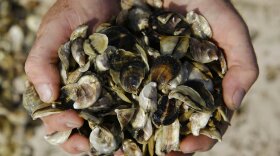-
From sponges to timber to oysters, the Forgotten Coast has proved adaptable — can it again?
-
The Florida Fish and Wildlife Conservation Commission has approved a management plan for a partial reopening for wild oyster harvesting at the beginning of January
-
Residents of Franklin County gathered to celebrate Gov. Ron DeSantis' recent signing of a law that bans drilling within 10 miles of the Apalachicola River Basin.
-
During their meeting Thursday, commissioners agreed to open a limited 94-acre harvesting area to any fisher that qualifies.
-
A "lottery" has been suggested to limit permits. Restrictions could also include a harvesting season from October through February and more.
-
Uthmeier says he'll refer the matter to Florida's DOGE to see if there's been financial mismanagement
-
Their bills would put rules in place for oil companies that drill for oil and gas near vulnerable bodies of water.
-
“The people of the Gulf Coast know what can happen when you have accidents with oil.”
-
While oyster harvesting there was halted in 2020, officials say reviving the industry would help the area's economy. It would resume in 2026.
-
The Apalachicola River and Bay have taken several hits—from major storms, to a “water war” between Florida, Georgia, and Alabama.
-
After years of struggling from both natural and manmade disasters, the bay is beginning to show signs of recovery. Both the water and the oysters are "in recovery mode."
-
Apalachicola Bay's wild oysters are showing signs they could rebound after years of decline. But the oyster's recovery is still fragile.
Play Live Radio
Next Up:
0:00
0:00
Available On Air Stations












